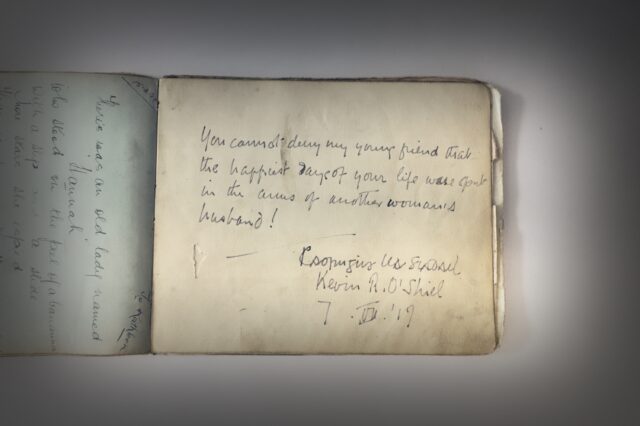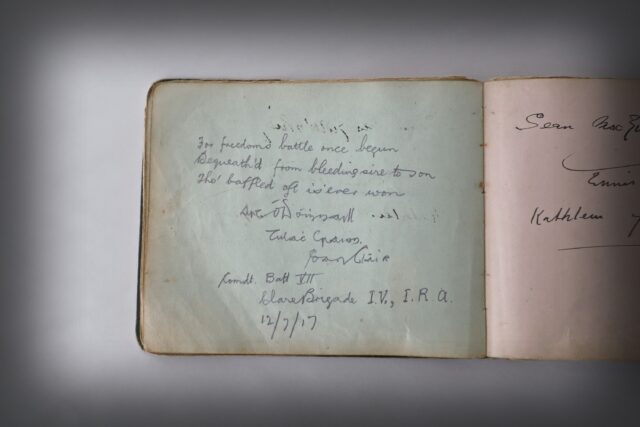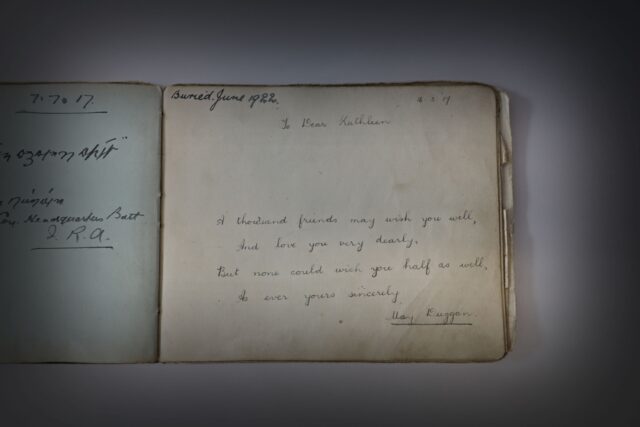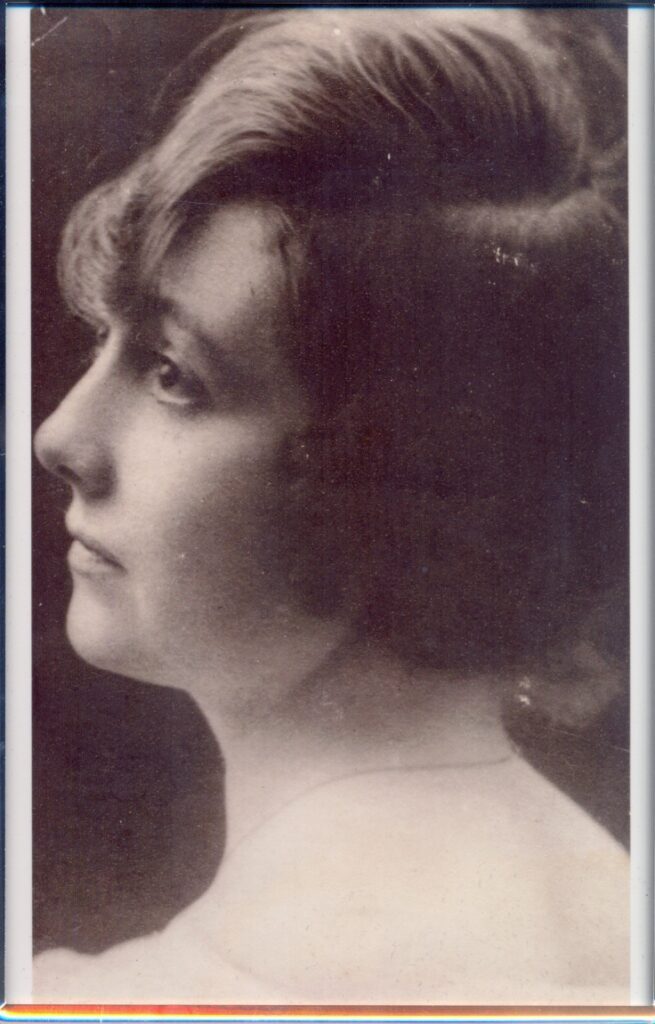Who was Kathleen Griffin?
Kathleen Griffin was born in Church Street, now Abbey Street, Ennis on the 26th March 1899. In 1917 she was a teenage member of Cumann na mBan, the women’s auxiliary of the Irish Volunteers and later the IRA. In late June and early July that year she kept an autograph book as she campaigned for Sinn Féin in the East Clare by-election. This was the election that marked the start of the political career of Eamon de Valera.
What is an autograph book?
Autograph books were a popular form of social media at one time and both men and women used them. During the by-election campaign, many of those who would shape the future of Ireland signed it. This album is now part of the collection at Clare Museum, Ennis.
Background to the 1917 East Clare by-election
The reason for the 1917 election was because the sitting MP for East Clare, Major Willie Redmond, had died in the First World War. The by-election to replace him took place against the backdrop of the Irish Convention. British Prime Minister David Lloyd George hoped to stem the rise of Sinn Féin by bringing all Irish parties together to agree on a Home Rule Ireland. He released all remaining rebels imprisoned in British gaols after the Easter Rising as a goodwill gesture. Once they arrived in Ireland on 17th June, many of these former prisoners made their way to Ennis. They stayed in the Old Ground Hotel, the headquarters of Sinn Féin’s election campaign. This is where Kathleen was often based.
The Signatories
Many of the entries in the autograph book were from these liberated rebels. The entries include political statements alongside signatures. This information was often useful for identifying some of the more obscure signatories.
There are a few names recorded in it that need no introduction. It includes three of those who signed the 1921 Anglo-Irish Treaty: Michael Collins, Eamonn Duggan and Arthur Griffith. Collins was coming to prominence in the republican movement during this time. His signature is notable because he recorded the date of his entry with the wrong year – 1916 instead of 1917. It suggests that the Easter Rising was not far from his mind.
Three radical women also appear. The best known is Constance Markievicz who was staying in the Old Ground Hotel during the election. Markievicz made two entries in the autograph book. One of them tells us that she went for a walk out the Quin Road with Kathleen one evening during the election.

Kevin R. O’Sheil’s entry to Kathleen Griffins album.
Kevin R O’Sheil also signed the autograph book. In his witness statement to the Bureau of Military history he gave an account of Markievicz at the centre of a scuffle. It happened during an Irish Party rally in O’Connell Square in Ennis during the election campaign. The RIC rescued her and escorted her back to the Old Ground Hotel and safety. We know from O’Sheil’s account that the RIC returned her via Arthur’s Row. This means she would have passed the entrance to Clare Museum which was part of a convent complex at the time.
Markievicz was also a well-known suffragette. Two other suffragettes who signed the autograph book were Jennie Wyse Power and Alice Milligan.
Constance Markievicz stayed in Jennie Wyse Power’s house on the night before The Easter Rising. Wyse Power was a co-founder of Cumann na mBan.
Alice Milligan‘s entry tells us that she arrived in Ennis without a coat. She came from a Protestant and Unionist family in County Tyrone. She was a close friend of Roger Casement and was well known in cultural and literary circles.
Lawrence Ginnell also left his name in the autograph book. He was an Irish Party MP who sympathized with the 1916 rebels. He would actually join Sinn Féin in October 1917. Ginnell left his name in Irish and English in the album, while Austin Stack’s entry is in Irish.
Frank Aiken travelled down from County Armagh to play his part in the campaign. He would become a prominent IRA commander during the War of Independence. Following independence, he would become the Irish Minister for External Affairs. He became Tánaiste in the 1960s not long before his retirement.
Among the Clare figures that appear in the autograph book is Art O’Donnell from Tullycrine. He became the Commander of the West Clare Brigade of the IRA at this time and was engaged in training and drilling his IRA volunteers. Patrick and Michael Brennan of Meelick, who were commanders of the East Clare Brigade are also recorded. Clare Museum possesses an autograph book that Patrick had with him in Frongoch. This album contains a few signatures from the by-election. While Patrick signed Kathleen’s album, he did not reciprocate, and her name does not appear in his.

Art O’Donnell’s entry to the album.
Among the rebel election campaigners were the names and verses from friends of Kathleen. These entries were non-political and often offered verses of ‘advice’ for Kathleen. They sometimes included sketches. Most of these friends were young women who were comrades in Cumann na mBan. A few of the entries have notes written by Kathleen recording the deaths of some of them between 1920-1923. It appears these young women were victims of illness at a young age.
One of them was May Duggan of Moyriesk, Quin, who died on 22nd June 1922 from a long illness. Among those who attended her funeral were Georgina Frost and Nan Hogan. Nan was in Cumann na mBan and would die young herself in June 1924. Georgina Frost. her friend, also made her mark in history in her own way.

May Duggan’s entry, made on 16 March 1917. Kathleen added ‘Buried June 1922’ when she died.
Kathleen’s later life
Kathleen avoided the misfortune that befell these friends. During the Irish War of Independence, she often broke curfew. Once she intervened when a teenage boy was caught out on the street by the Black and Tans. She claimed he was her brother and that she was out looking him. She brought him to her home and to safety. Soldiers were much less hostile than the RIC or ‘The Tans’. One of those soldiers, called Billy Rawlings, would catch her breaking curfew many times. He threatened to arrest her, but instead, they married in 1922.
Kathleen and Billy settled in Ennis during the early years of the Irish Free State. They raised a family in Francis Street in the town, close to where she grew up. In the 1940s the family moved to England for economic reasons. Kathleen took the autograph book, a treasured possession, with her
The album remained important to Kathleen throughout her life. While she hinted at its historical importance, she rarely discussed it. Souvenir hunters, one of them a priest, tore out three pages with Eamon de Valera’s signatures, over the years. When she died in 1990, Kathleen was a great-grandmother in her 91st year. Her keepsake passed on to her granddaughter Marian Trevillion. Marian donated it to Clare Museum in 2017 where it is now available for the public benefit.
A full list of all the names in the autograph book can be found here.


Comments
Dean Bourke on 8 April 2023:
John mcgann on 19 April 2024: